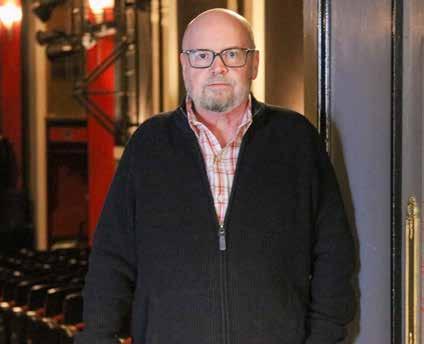
10 minute read
POSTAL BANKING
Back to the Future Corporate pressure ended postal banking in 1968. It’s time to bring it back }}
TREVOR HUTCHINSON, CONTRIBUTING EDITOR
Advertisement
One of the very first things that the new Dominion of Canada did as a country, way back in April 1868, was create a postal bank. The idea was to create a banking system that Canadians could access easily — and to serve customers that the established banks of the time showed little interest in, namely lower-income customers and those in remote communities.
Successful lobbying by the banking industry led to the elimination of the postal bank in 1968. Virtually all of the key players in our current postal system — Canada Post; Canadian Union of Postal Workers (CUPW) and the Canadian Postmasters and Assistants Association (CPAA) — have examined the idea of re-establishing a postal bank.
Canada Post Corporation, an arm’s-length Crown corporation, conducted a four-year study on postal banking in the early 2000s. For reasons as yet unexplained by the corporation, 711 of the 801 pages of the report were blacked out, and all those pages were revealed only after a freedom of information request. One sentence on postal banking did survive the initial redaction: Canada Post describes the possibility of a postal bank as a “win-win strategy.” (Canada Post did not respond to questions posed by the Advocate on the study.) The last time the House of Commons discussed postal banking was in October 22, 2018 — which happened to be the day that members of CUPW began rotating strikes. The motion was defeated two days later.
Kawartha Lakes-Haliburton Brock MP Jamie Schmale voted against the motion, which proposed a special committee to establish a plan for a postal banking system. In an interview with the Advocate Schmale said that while he too was concerned with access to banking for rural residents, he said the motion as stated “presented postal banking as a done deal” with no other options being considered.
There is a perception amongst some critics of postal banking that the idea is just a way to save jobs in an industry that is going through severe flux with the decline of letter mail and the increase of package delivery. Brenda McCauley, president of the CPAA (which represents more than 11,000 workers in more than 3,200 locations) says that postal banking is about more than jobs. McCauley acknowledges that postal banking would address job security and possible growth for Canada Post. It would also address the gender wage gap (the CPAA’s membership is 95 per cent female nationally and 97.6 per cent female in Ontario). But according to McCauley, “postal banking is bigger than that. It’s an important issue. It’s important to rural Canadians.”
CONT’D ON PAGE 12
What is postal banking?
Quite simply, it’s being able to do one’s banking at the local post office. Imagine having the option to have basic banking services like savings and chequing accounts and bill payments right at the local post office. Later, services like mortgages, loans, and investments, could be added. Postal banking existed in Canada up until 1968 until Canada decided to hand more power over to the private sector and the big banks.
Postal banking could be lucrative in Canada

New Zealand: Kiwibank generated 81% of New Zealand Post’s after tax profits. Switzerland: PostFinance produced 48% of Swiss Post’s operating profits. Italy: BancoPosta profits allowed the Italian post office to make 57 million Euros in profits ($86.1 million CAD) in spite of losses incurred by its postal business. France: La Banque Postale’s operating profits of 842 million Euros ($1271.6 million CAD) made a significant contribution to Le Groupe La Poste’s operating profits of 719 million Euros ($1085.8 million CAD).
Sources: New Zealand Post, Swiss Post, Poste Italiane and Le Groupe La Poste, 2014
There is compelling data suggesting a postal bank could both be profitable and provide customers with lower-cost financial services. Postal banking is profitable in countries like Switzerland, New Zealand, Italy and France, even when some of those countries’ traditional postal services lose money.
There are some compelling arguments claiming that postal banking could address several problems right here in Kawartha Lakes. SMALLER COMMUNITIES CAN LOSE OUT
The big banks are getting out of smaller communities. In 1990 there were 7,694 branches in Canada. According to the Canadian Bankers Association (CBA), by 2017 that number fell to 5,907 branches. Having small branches no longer seems to be part of the business plans of the big five banks. In June 2018, for example, RBC announced that it plans to reduce its number of branches by reducing the total square footage of its banking locations by 20 per cent. Simply put, smaller bank branches in smaller communities are a dying breed. Residents of Omemee and Woodville do not to be reminded of this trend, given the recent closure of bank branches in those communities. EXISTING BANK SERVICES ARE EXPENSIVE
Canadian banks are among the most profitable in the world. Since 89 per cent of us use one of the big six banks, we are beholden to their rate and fee structures. A recent survey indicated that baby boomers have already paid an average of $2,200 over their lifetime in bank fees; millennials have paid an average of $760; and Gen-Xers have paid an incredible $2,600 in lifetime fees. And RBC — the one that plans to decrease branch space by 20 per cent? It made a record $12.9 billion in net profit for the fiscal year 2019. It is no wonder most bank CEOs made more money by lunchtime on January 1 than most people reading this will all year, according to the Canadian Centre for Policy Alternatives.
McCauley notes that while it existed, the “postal bank had manageable fees.” Without having to support exorbitant executive compensation or be concerned about shareholder return, a postal bank can charge substantially lower fees. INDIGENOUS COMMUNITIES
There are only 66 bank branches in the 700-plus Indigenous communities in Canada, which means more than 90 per cent of these communities don’t have local access to a bank — yet one more example where our coutry is systemically prohibiting economic growth in Indigenous communities who are inclined to have less access to community-based loans, for instance. IN-PERSON BANKING IS STILL AROUND
While many of us might do most of our banking online or using mobile platforms, many Canadians still use branches. No doubt our use of digital banking is one of the main factors in the decline of actual bank branches. The CBA reports that 68 per cent of Canadians do “most of their banking”
digitally and in-branch usage is dropping, but people still need branches. A study done by Credit Union Central of Canada showed that in 2015, 50 per cent of Canadians still used a bank on occasion and only 10 per cent of Canadians never use a branch. Older people are more likely to visit a branch in person. Given that Kawartha Lakes has a population with an above-average age we have to ask ourselves: How will our seniors who are not comfortable with technology or with no access to public transportation access financial services if or when the remaining branches leave? CHEQUE-CASHING BUSINESSES PUNITIVE
While so-called “payday loan” companies might seem like an alternative to local bank branches, the exorbitant charges for cashing a cheque at these companies and the enticements they offer for loans end up legally robbing the most economically disadvantaged among us. The federal government’s own figures demonstrate the cost of borrowing $300 over two weeks: borrowing from a line of credit costs $5.81; from a credit card, $7.19; from a payday loan company, $63.00 — equivalent to a 546 percent annual interest rate. BANKING SERVICES’ SILVER LINING
It is true that we no longer send regular mail as much as we used to. The creation of a new banking unit within Canada Post would provide a source of revenue to continue the less profitable door-toCONT’D ON PAGE 22
PHOTO: RODERICK BENNS


Brenda McAuley, president of the Canadian Postmasters and Assistants Association, with postmaster Kate from Tamworth, Ontario. The village has been lobbying for banking at the post office after losing its last bank branch.
RESIDENTIAL & COMMERCIAL CLEANING Licensed, Insured and WSIB Covered

Proudly Serving Lindsay, Bobcaygeon, Peterborough & In-between.
Book Your cleaning now!
Office Cleaning Storefront Window Cleaning Residental Cleaning Tile & Grout Cleaning
Rome/Florence/Venice, Italy VALUE $5,000 – PLUS $1,000 SPENDING MONEY Trip Package for 2
Includes Round Trip Flights from Toronto; Accommodation for 9 days/7 nights (includes plane travel); 7 meals; Transfers; Train; and Taxes (no cash value; non-transferable; May to October 2020, dates subject to availability) Arranged through Kawartha Lakes Travel Plus, Lindsay via Air Transat

Draw Date: March 14, 2020 at Women’s Resources Marquee Event, Academy Theatre
Purchase in Lindsay at: Women’s Resources, 22 Russell St. E.•Vicky’s Values, 50 Mary St. W. For other locations to purchase tickets, please contact Women’s Resources Thank you to our Media Sponsors: Experienced Legal Advice for your Residential & Recreational Transactions & Estate Planning Experienced Legal Advice for your Residential & Recreational Transactions & Estate Planning Experienced Legal Advice for your Residential & Recreational Transactions & Estate Planning
Experienced Legal Advice for your Residential & Recreational Transactions & Estate Planning Experienced Legal Advice for your Residential & Recreational Transactions & Estate Planning Experienced Legal Advice for your Residential & Recreational Transactions & Estate Planning Experienced Legal Advice for your Residential & Recreational Transactions & Estate Planning STAPLES & SWAIN professional corporation Barristers, Solicitors, Notaries
Residential & Recreational Purchases,Sales & Refinancing Residential & Recreational Purchases, Sales & Refinancing Residential & Recreational Purchases,Sales & Refinancing

Residential & Recreational Purchases,Sales & Refinancing Contract Preparation & Review Wills & Powers of Attorney Business Succession Planning Estate Administration Incorporation Partnership & Shareholder Agreements Residential & Recreational Purchases, Sales & Refinancing Contract Preparation & Review Wills & Powers of Attorney Business Succession Planning Estate Administration Incorporation Partnership & Shareholder Agreements Residential & Recreational Purchases,Sales & Refinancing Contract Preparation & Review Wills & Powers of Attorney Business Succession Planning Estate Administration Incorporation Partnership & Shareholder Agreements 10 William St. S., Lindsay (705) 324-6222 www.staplesswain.com Dedicated to Excellence Since 1959 Heather Richardson Angus McNeil Residential & Recreational Purchases, Sales & Refinancing Contract Preparation & Review Wills & Powers of Attorney Business Succession Planning Estate Administration Incorporation Partnership & Shareholder Agreements Contract Preparation & Review Wills & Powers of Attorney Business Succession Planning Estate Administration Incorporation Partnership & Shareholder Agreements Contract Preparation & Review Wills & Powers of Attorney Business Succession Planning Estate Administration Incorporation Partnership & Shareholder Agreements Contract Preparation & Review Wills & Powers of Attorney Business Succession Planning Estate Administration Incorporation Partnership & Shareholder Agreements 10 William St. S., Lindsay (705) 324-6222 www.staplesswain.com Dedicated to Excellence Since 1959
New skills. New possibilities. Improve your future with more skills through Fleming’s Continuing Education.
Online and in-person courses Professional certificates

Explore your options: flemingcollege.ca/ con_ed 1.888.269.6929
HOW HAS CONTINUING YOUR EDUCATION IMPACTED YOUR CAREER?
Joyce completed her Medical Office certificate program online through Fleming College Continuing Education
When I began taking the medical office certificate program online I had been working in the medical field for some time, but knew I needed more education if I wanted to pursue other jobs. Near the end of my online learning through Fleming College I was able to get a new job in the medical office field. Thanks to the online courses at Fleming College, I was able to continue working and am thriving in my new position.
Are you looking for a meaningful, people-focused career?

The Personal Support Worker program gives you extensive training to provide practical support services to individuals and families in need of help. flemingcollege.ca askus@ flemingcollege.ca Apply now. Start in May or September at Fleming College’s Campus in Peterborough or Cobourg.

Program Highlights: • Graduate in two semesters and start your career - over 90 per cent employment rate - you might be hired before you finish the course • 400 hours of relevant theory and lab training plus 3 different placements • Course content related to long term care and to community care to diversify your experience • Curriculum follows ministry standards and is widely recognized by agencies and employers • Wide range of career opportunities and workplace settings • Bridge to Practical Nursing available for further career options









